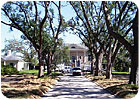Taking the Longue Vue in the Big Easy: A Case Study

When dealing with a commercial water damage scenario, getting the water out can be the least of your problems. Having great drying equipment and a well-trained staff will take care of the water, but the logistical and financial obstacles will most often be your biggest challenges.
It is the responsibility of the drying contractor to determine what steps to take to mitigate the loss and protect the structure from secondary damage, and at what cost. The contractor has to make decisions about equipment based on many factors: the ambient conditions; the conditions of the structure and contents; the customer’s needs and the cost of saving the building.
An example of overcoming obstacles is a drying project Water Out Phoenix took on at the Longue Vue House and Gardens in New Orleans last year. The project began in September 2005 and was completed in April 2006. The project was riddled with difficulties from the beginning, and it was up to the Water Out Phoenix technicians to figure out the steps necessary to save the historic structure.
The Longue Vue House and Gardens is located within the New Orleans Country Club and is on the historic building register. The house was originally built by the Sears & Roebuck Family in the 1940s and is now a public museum, with an estimated combined property and content value in excess of $100 million (the museum curator, Lydia Schmaltz, would argue this figure is very conservative as much of the collection is priceless).
As a result of Hurricane Katrina and the levy breaches that followed, the 5,000-square-foot basement of the house was flooded with more than 7 feet of contaminated groundwater. The basement housed the buildings main boilers and HVAC systems along with the electrical feeds and panels from the grid. Needless to say, these systems required replacement, but it would be months before replacement equipment could be installed. The result was a complete failure of the climate control systems, causing the historic museum and its collection to be exposed to unregulated temperatures and humidity. The curator stated the climate must be maintained at 70 degrees F and 50 percent relative humidity (RH). On inspection, the temperature was in the low 90s and the RH was around 80 percent. The collections and the historic structure were at grave risk.
Obviously, tear out and replacement of the contents, walls and floors was not an option for this project. The goal was to protect and save the valuable collections and structure.

The team started work immediately, providing emergency power with several large generators and contracting a HAZMAT water extraction team to remove the contaminated water from the basement and clean the area. Once removal was complete, the basement and crawlspaces were dried using the Water Out Convectant drying process.
With the removal of the standing water from the basement and the moisture trapped in the stone walls, the relative humidity in the building began dropping immediately. Now the concern was how to control the climate in the rest of the building. Without an operational HVAC system, it would be virtually impossible to maintain a temperature of 70 F and a RH of 50 percent in New Orleans in September (or any other month, for that matter).
Drying the basement was not a problem. However, upstairs in the museum, due to the delicate nature of the contents and the structure, restoring the climate to the preferred conditions of 70 F and 50 percent RH could not exceed a 5 percent rate of change per 4-hour period. The curator preferred an even slower rate of climate change. Water Out’s Convectant technology would not be the right tool for the museum. The team worked very closely with the curator, and through constant monitoring and the use of equipment specifically designed to solve the problem of maintaining the humidity level in buildings, the technicians were able to achieve a 2 percent rate of change in the climate. They kept the climate controlled until the HVAC system was replaced, more than six months after the start of the project.
The collection and home were saved. Inspections from fine arts appraisers stated that the efforts of Water Out Phoenix in mitigating the secondary damages were successful and resulted in zero claims for fine arts damages.
The final bill was $590,000, about the same cost as the initial estimate to pack out the priceless contents, and this included the subcontracted HAZMAT work. The mitigation effort was priceless to the curator and the community. An estimated net savings for the project totals almost $100 million.
It is important in every drying job to get the water out of the building and get the temperature and humidity under control as soon as possible, but the most important part of any job is understanding the building and contents, the concerns of the customer and what your equipment is capable of handling.
Water Out Phoenix recognized and embraced these very important facets of drying at Longue Vue House and Gardens. By employing the right equipment, closely monitoring the job and calling in the appropriate experts for assistance, they were able to save a historic building and a priceless collection of antique furniture and irreplaceable artwork while saving a sizable amount of money for the insurance company. If you liked this feature circle 130 on page 51.
Looking for a reprint of this article?
From high-res PDFs to custom plaques, order your copy today!





